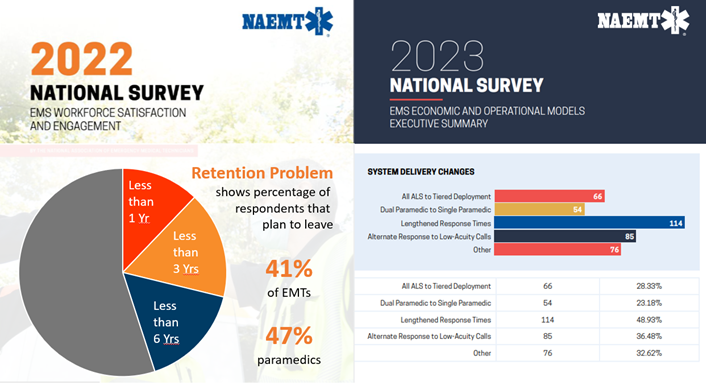There is plenty of data in the world, the key to improving performance is to discover the right information and make an appropriate decision, based on facts, in time to change outcomes for the better. Computers are quite useful in aggregating and processing data to distill information in support of the decision-making process, but artificial intelligence and machine-learning has increased our expectations of cyber assistance. Although it is not time to completely hand over critical decision-making to an automaton, there is a lot we can learn from leveraging algorithms to offer appropriate decisions in real-time.
Public safety professionals make many critical decisions every day. Honing an individual’s decision-making prowess through experience can be a slow and sometimes expensive means toward improvement. While building personal skills is valuable, there is no guarantee that the increasingly knowledgeable individual will remain in the particular decision-maker role. There must also be consideration of the decisions made during the early slope of the learning curve. The fact that we can do better should always be an encouragement to seek operational improvement.
A well-established class of software known as “decision support systems” have long sought to advance the quality of the decision-making practice. Since any decision requires the gathering of data and comparison of possible alternatives, these computer applications aggregate loads of information to simplify access for the professional. Some more advanced examples of this software may even integrate models, such as plume analysis or fire behavior, to estimate the impact of potential changes to the input data based on specific actions or conditions. The functional core of all systems in this cohort is that they only present options and leave the actual decision to the discretion of the user.
Shifting the focus from the simple presentation of facts to performing complex tasks without explicit instruction from the data consumer in an evolving category of applications described as “decision engines“. The point of these automated functions is to present preferred solutions to immediate concerns that utilize a larger corporate logic. By integrating the organizational experience of lessons learned with strategies approved by administrators, a higher level of operational consistency of outcomes can be achieved. This follows the same logic as developing protocols to guide medical treatments in the field. Most importantly, these preferred decisions can be available within the demanding real-time operational timeframe.
The term “decision engine” is more than a new marketing phrase to differentiate products, but provides three key distinctions beyond the basic “decision support system” applications. These characteristics include:
- Standardized decision criteria
- Real-time actionable recommendations
- Quantitative functionality for decision review
The decision criteria is codified in some form of a standardized rule base to allow the institutional knowledge gained through experience to be immortalized and managed for accessibility to immediate situations. The way these criteria are stored can vary, but must be available as algorithmic expressions for the data to be automatically manipulated to produce a specific decision option. Within the MARVLIS suite of applications are several decision engines. One engine utilizes stored query sets that categorize units, statuses, and requests-for-service by acuity to be combined with recommendation expressions to form the criteria that automates unit assignment recommendations. It is also important that the decision criteria be flexible to adjust quickly to any changes in the business environment. External factors such as rapid fluctuation in fuel prices or staffing issues can impact the command-level methodology of making specific decisions. The ability to alter criteria quickly provides immediate consistency at the staff level with these changing objectives.
A second defining factor is the real-time support of improved outcomes achieved by providing logical and defensible actions at the time a decision must be made. Another engine within MARVLIS utilizes level-specific, time-of-day posting plans developed from weighted demand analysis automatically combined with move penalties to suggest detailed location reassignments by unit in preparation for future service requests. Not only should decisions be standardized to meet current agency directives, but they must be provided within the moment that a decision is being considered. The recommended decision option, however, should not constrain the decision-maker as their “ceiling of competence“, but establish a “floor of support” between individual decision-makers across shifts and experience levels to minimize rouge decisions based on “ritualized responses” instead of more “appropriate responses” that are situationally-specific. The decision made at any given time should not be solely dependent on who is in the role at the moment.
Finally, there must be a review methodology to report outcome measures and allow for lessons to be learned from discrepancies in the decisions made during unique situations. After all, the purpose of an automation logic is not just about making better decisions, but ultimately developing better decision-makers. A reporting database such as the one maintained by MARVLIS to detail what was known and when is critical to understanding the decisions enacted at the moment. Hindsight may be twenty-twenty, but simply using outcomes can be an unfair bar for measuring appropriate decisions in an evolving situation. It may be better to account for the coverage of recommended demand maintained based on a measured forecast for evaluation of performance, for instance, than simply reviewing specific results at the end of an event. While both must be considered, the weight of an encouragement for consistency should be applied to mitigate any lone exception. Similarly, a less optimal automated decision recommendation can benefit from the experience of an identified exception to improve the rule base to cover such a repeated event in the future.
The decision engine stands as a next-level strategy beyond the traditional decision support system to provide additional consistency and improved efficacy in public safety operations. Due to many of the current challenges in providing emergency services, the time spent developing the decision model along with the decision maker can be a prudent investment.











